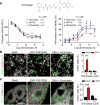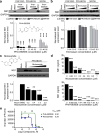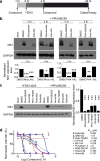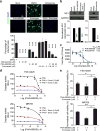Identification of small-molecule inhibitors of Zika virus infection and induced neural cell death via a drug repurposing screen
- PMID: 27571349
- PMCID: PMC5386783
- DOI: 10.1038/nm.4184
Identification of small-molecule inhibitors of Zika virus infection and induced neural cell death via a drug repurposing screen
Abstract
In response to the current global health emergency posed by the Zika virus (ZIKV) outbreak and its link to microcephaly and other neurological conditions, we performed a drug repurposing screen of ∼6,000 compounds that included approved drugs, clinical trial drug candidates and pharmacologically active compounds; we identified compounds that either inhibit ZIKV infection or suppress infection-induced caspase-3 activity in different neural cells. A pan-caspase inhibitor, emricasan, inhibited ZIKV-induced increases in caspase-3 activity and protected human cortical neural progenitors in both monolayer and three-dimensional organoid cultures. Ten structurally unrelated inhibitors of cyclin-dependent kinases inhibited ZIKV replication. Niclosamide, a category B anthelmintic drug approved by the US Food and Drug Administration, also inhibited ZIKV replication. Finally, combination treatments using one compound from each category (neuroprotective and antiviral) further increased protection of human neural progenitors and astrocytes from ZIKV-induced cell death. Our results demonstrate the efficacy of this screening strategy and identify lead compounds for anti-ZIKV drug development.
Conflict of interest statement
The authors declare no competing financial interests.
Figures




Similar articles
-
High-Content Screening in hPSC-Neural Progenitors Identifies Drug Candidates that Inhibit Zika Virus Infection in Fetal-like Organoids and Adult Brain.Cell Stem Cell. 2017 Aug 3;21(2):274-283.e5. doi: 10.1016/j.stem.2017.06.017. Epub 2017 Jul 20. Cell Stem Cell. 2017. PMID: 28736217 Free PMC article.
-
Identification of Inhibitors of ZIKV Replication.Viruses. 2020 Sep 18;12(9):1041. doi: 10.3390/v12091041. Viruses. 2020. PMID: 32961956 Free PMC article.
-
The Compound SBI-0090799 Inhibits Zika Virus Infection by Blocking De Novo Formation of the Membranous Replication Compartment.J Virol. 2021 Oct 27;95(22):e0099621. doi: 10.1128/JVI.00996-21. Epub 2021 Sep 1. J Virol. 2021. PMID: 34468177 Free PMC article.
-
Strategies for Zika drug discovery.Curr Opin Virol. 2019 Apr;35:19-26. doi: 10.1016/j.coviro.2019.01.005. Epub 2019 Mar 7. Curr Opin Virol. 2019. PMID: 30852345 Review.
-
Recent trends in ZikV research: A step away from cure.Biomed Pharmacother. 2017 Jul;91:1152-1159. doi: 10.1016/j.biopha.2017.05.045. Epub 2017 May 17. Biomed Pharmacother. 2017. PMID: 28531943 Review.
Cited by
-
3D engineered tissue models for studying human-specific infectious viral diseases.Bioact Mater. 2022 Sep 22;21:576-594. doi: 10.1016/j.bioactmat.2022.09.010. eCollection 2023 Mar. Bioact Mater. 2022. PMID: 36204281 Free PMC article. Review.
-
Reverse genetic approaches for the development of Zika vaccines and therapeutics.Curr Opin Virol. 2020 Oct;44:7-15. doi: 10.1016/j.coviro.2020.05.002. Epub 2020 Jun 18. Curr Opin Virol. 2020. PMID: 32563700 Free PMC article. Review.
-
Building the brain from scratch: Engineering region-specific brain organoids from human stem cells to study neural development and disease.Curr Top Dev Biol. 2021;142:477-530. doi: 10.1016/bs.ctdb.2020.12.011. Epub 2021 Feb 18. Curr Top Dev Biol. 2021. PMID: 33706925 Free PMC article.
-
New life for an old drug: In vitro and in vivo effects of the anthelmintic drug niclosamide against Toxoplasma gondii RH strain.Int J Parasitol Drugs Drug Resist. 2019 Apr;9:27-34. doi: 10.1016/j.ijpddr.2018.12.004. Epub 2018 Dec 21. Int J Parasitol Drugs Drug Resist. 2019. PMID: 30599391 Free PMC article.
-
Targeting Human Proteins for Antiviral Drug Discovery and Repurposing Efforts: A Focus on Protein Kinases.Viruses. 2023 Feb 19;15(2):568. doi: 10.3390/v15020568. Viruses. 2023. PMID: 36851782 Free PMC article. Review.
References
-
- Dick GW, Kitchen SF, Haddow AJ. Zika virus. I. Isolations and serological specificity. Trans R Soc Trop Med Hyg. 1952;46:509–520. - PubMed
-
- D’Ortenzio E, et al. Evidence of Sexual Transmission of Zika Virus. N Engl J Med. 2016;374:2195–2198. - PubMed
-
- McCarthy M. Zika virus was transmitted by sexual contact in Texas, health officials report. Bmj. 2016;352:i720. - PubMed
Publication types
MeSH terms
Substances
Grants and funding
- P01 NS097206/NS/NINDS NIH HHS/United States
- T32 GM007309/GM/NIGMS NIH HHS/United States
- R01 MH105128/MH/NIMH NIH HHS/United States
- R37 NS047344/NS/NINDS NIH HHS/United States
- U19 MH106434/MH/NIMH NIH HHS/United States
- R01 MH106056/MH/NIMH NIH HHS/United States
- R01 NS047344/NS/NINDS NIH HHS/United States
- T32 GM008752/GM/NIGMS NIH HHS/United States
- ZIA TR000018-02/ImNIH/Intramural NIH HHS/United States
- R56 MH101454/MH/NIMH NIH HHS/United States
- U01 AG046170/AG/NIA NIH HHS/United States
- T32 MH015330/MH/NIMH NIH HHS/United States
- R21 NS095348/NS/NINDS NIH HHS/United States
- ZIA TR000269-01/ImNIH/Intramural NIH HHS/United States
- R21 AI119530/AI/NIAID NIH HHS/United States
- R01 MH101454/MH/NIMH NIH HHS/United States
- R56 NS047344/NS/NINDS NIH HHS/United States
- P50 AG005138/AG/NIA NIH HHS/United States
- R01 NS048271/NS/NINDS NIH HHS/United States
LinkOut - more resources
Full Text Sources
Other Literature Sources
Medical
Research Materials

